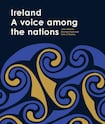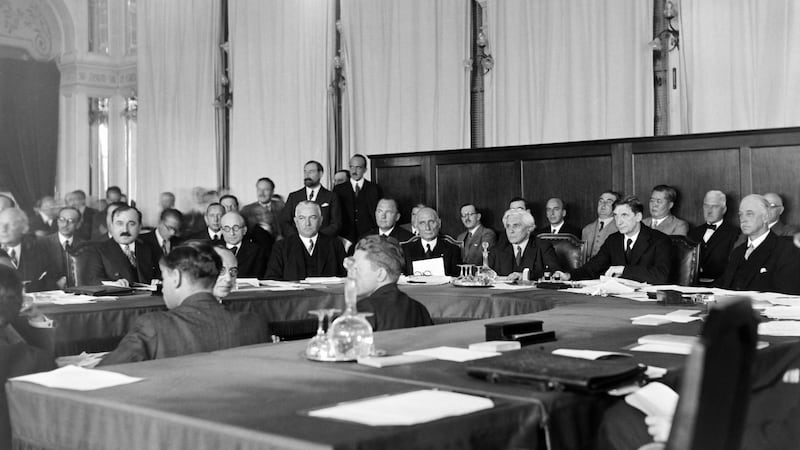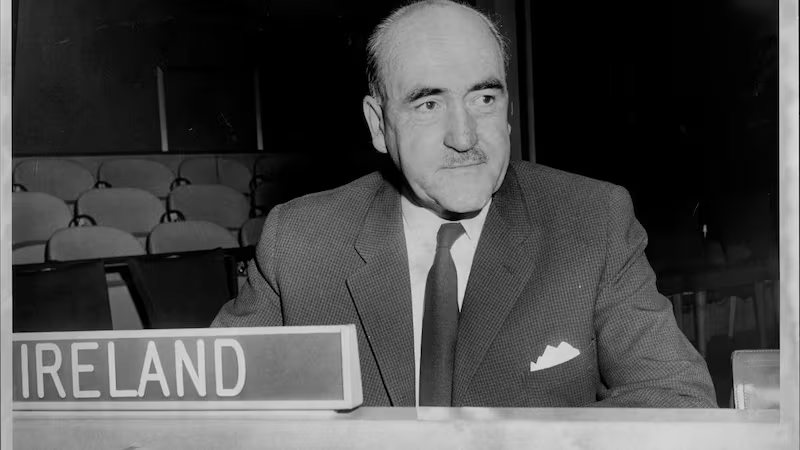
Exactly 100 years ago, the British prime minister David Lloyd George asserted in the House of Commons in relation to the demand for an Irish republic that “any attempt at secession will be fought, with the same determination, with the same resources, with the same resolve, as the northern states of America put into the fight against the southern states. It is important that this should be known not merely throughout the world, but in Ireland itself.”
As he spoke the leader of the Irish republican movement, Éamon de Valera, was in that same America, attempting to drum up political support and funds for the declared Irish republic. What both men knew was that theirs was a propaganda battle as well as a political and military challenge and making their respective cases to the wider world was essential.
Arguably Irish republicans did a better job during that propaganda war. Achieving an international profile for the Irish question was no easy task but the determination was evident a century ago, a reminder, as underlined by this book, that “Ireland has the unusual distinction of having had a foreign policy and a diplomatic service before there was an internationally recognised Irish state”.
The department of foreign affairs was first established in January 1919, and almost a century later, in 2018, it had a staff of over 1,800 and 90 diplomatic missions across the world during a year when there were 855,000 applications for Irish passports.

This centenary history of foreign policy reads as a celebration rather than critical analysis; an official history sponsored by what is now the Department of Foreign Affairs and Trade and published in association with the Royal Irish Academy and the National Archives. It does not challenge sacred cows but does provide a useful, succinct and well-written narrative overview of the milestones of foreign policy since 1919. Most strikingly it is a lavish photographic history of the subject. Many of the photographs here have not been published before, and they are evocative, textured and multilayered. Much credit is due to those who foraged for them, collated and captioned them.
This book is a reminder that, although Anglo-Irish affairs were to dominate for decades, it was ultimately recognised that a wider reach was necessary because, as historian Desmond Williams observed in the 1970s, “two principal points arise for a small state: policy cannot be a single grand design and freedom of action is limited”.
Williams’s observation is not quoted in this book, as it is not one that engages with different historical interpretations. That can lead to a sense that too many tricky foreign policy dilemmas of yesteryear are alluded to or glossed over rather than dissected, including attitudes to the Commonwealth and refugee policy, but the book does underline significant achievements for a small state and the sustained quality of Irish diplomatic representation.
Web of envoys
A measure of the foreign policy mountain to be climbed was that when Seán T O’Kelly travelled in 1919 to make the unsuccessful case for Ireland to receive a hearing at the Paris Peace Conference, his nationality was listed as “Britannique” on his application for an identity card. Sinn Féin nonetheless organised a “global web of envoys” stretching from Argentina and Chile to Australia and New Zealand and back to the old and new states of Europe, an infant diplomatic service subsequently torn apart by the Anglo-Irish Treaty. The book is a reminder of the influence of key individuals, including the gifted, secretive Francophile, lawyer and linguist Joseph Walshe, the “founding father” of the Department of External Affairs (as it was retitled in December 1922), who served as departmental secretary in 1922-1946 and was hostile to women in the service, a reminder of what a male world this was and remained.
For all the focus on such turning points as joining the League of Nations, neutrality during the second World War, finding a voice at the UN and membership of the EEC, there are interesting snippets and asides to remind us of soft and under-the-radar diplomacy, including William Craig Martin’s insurance office, “which maintained an Irish presence in Shanghai in the inter-war years” or Michael MacWhite’s failed effort to use a personal relationship with US president Roosevelt to open negotiations for an Irish-American trade agreement in the 1930s. It was also revealing that in 1952 Frederick Boland in London as ambassador to the UK could write to the Department of External Affairs: “I don’t suppose that any single question has been given more anxious and painstaking consideration in the department within the last 7 or 8 years than this matter of the migration of young and immature Irish girls to this country.”

In the post-second World War period, given Ireland’s lack of involvement in the UN (until it joined in 1955) and Nato, much information obtained about international affairs was “second hand or diluted”. As minister for external affairs, Frank Aiken was frustrated at not being able to obtain weapons from the US, and by the early 1950s “Ireland was no closer to being reunited and remained effectively undefended”, with a semi-detached stance on European integration and no diplomatic missions to eastern Europe until 1974. Foreign policy by the late 1950s had become avowedly pro-western and anti-communist, while under the stewardship of Aiken, the UN became a central focus, involving streaks of independence, including support for discussing the representation of China. There was also the notion of a “middle power” role for Ireland in relation to peacekeeping.
Towards Europe
As taoiseach from 1959, Seán Lemass ensured a decisive shift towards Europe and while, in 1961, “vague notions circulated about Irish unity within a united Europe, the nightmare scenario facing Dublin was that Britain might gain EEC entry before Ireland”. With the outbreak of the Troubles, engagement with events just 100 miles from Dublin was, ironically, “new territory” for the department, which changed its title to the Department of Foreign Affairs, but it quickly adapted in relation to exploratory contacts, confidential negotiations and through the Anglo-Irish Agreement of 1985, a “structured channel” was put in place to address difficulties. The importance of diplomats like Dermot Gallagher, who had the unique distinction of being an official involved in both the negotiation of the Sunningdale and the Good Friday Agreements, is highlighted.
In relation to the EEC, it is suggested the original “almost transactional approach evolved into an awareness that Irish interests were also served by the broader success of the EU”, which explains why Ireland’s largest diplomatic mission is the permanent representation to the EU in Brussels, and Ireland “was unique among EU member states in maintaining an embassy in every EU capital”.
Remarkably, it took until 1996 for the first White Paper on Irish foreign policy to appear and it focused on the UN, EU, peacekeeping, human rights, the environment, development aid, the diaspora and the degree of importance attached to international profile, but the thorny issue of Irish neutrality was not far from the surface subsequently in the context of the Iraq war and the use of Shannon airport.
The overwhelmingly positive portrait of foreign policy offered here can be challenged; after all, elsewhere, one of this book’s authors, Michael Kennedy, has suggested there was a pragmatic selfishness to much foreign policy. While there was principled action on occasion, Kennedy has cast a cold eye on the idea of 20th-century Ireland punching above its weight internationally: “Ireland survived, Ireland looked after itself.” This, I suspect, is not the kind of conclusion that would pass muster with the mandarins desiring an uncritical, if visually powerful and handsomely produced book.
Diarmaid Ferriter is professor of modern Irish history at UCD and an Irish Times columnist. His most recent book is The Border: The Legacy of a Century of Anglo-Irish Politics (Profile Books)












